Installed in the main exhibition space, this could have been a blockbuster show introducing a large audience to an important moment in Russian Theatre; but tucked away in the Department of Theatre and Performance, where spaces are narrow and galleries small, there is little room to show off these superb exhibits to their best advantage. Only the initiated will, I fear, brave these claustrophobic corridors and persevere long enough to appreciate the goodies on offer.
Faced with walls painted bright red, labels hung too low and hard to read, copious detail about each production but little contextualising information, my inclination was to exit immediately. It took steely determination (and the fact that I had to write this review) to make myself stay, which is a great shame, because the period is fascinating and the exhibits second to none.
 So here is some background information that might help you enjoy this potentially stunning exhibition. The show begins in 1913 when visionary directors like Vsevolod Meyerhold were attempting to realign theatre so that it would appeal to a broader public. The psychological realism that his teacher, Konstantin Stanislavsky was aiming for when directing Chekhov, for instance, was to be replaced by “bio-mechanics”, a forerunner of the physical theatre currently practiced by companies such as DV8 and Theatre de Complicite, which emphasises collective action rather than individual motivation.
So here is some background information that might help you enjoy this potentially stunning exhibition. The show begins in 1913 when visionary directors like Vsevolod Meyerhold were attempting to realign theatre so that it would appeal to a broader public. The psychological realism that his teacher, Konstantin Stanislavsky was aiming for when directing Chekhov, for instance, was to be replaced by “bio-mechanics”, a forerunner of the physical theatre currently practiced by companies such as DV8 and Theatre de Complicite, which emphasises collective action rather than individual motivation.
Rather than foregrounding the spoken word, actors were encouraged to practice skills like gymnastics, dance and juggling and explore physical rather than emotional expression. Characters tended to be stereotypes – a policeman, soldier, singer, nurse or bourgeois – and often landed in farcical or surreal situations.
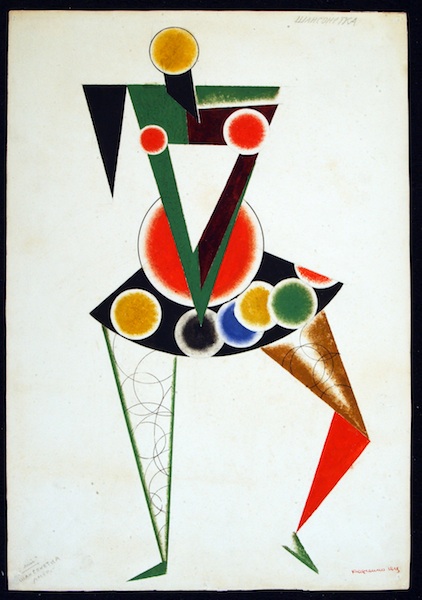 Meyerhold’s aim was to create a synthesis of sound and movement in which sets, costumes and lighting – designed by avant garde artists such as Malevich, Tatlin, Exter, Stepanova (pictured above left, Vavara Stepanova's costume design for Tarelkin's Death, 1922) and Rodchenko (pictured right, Alexander Rodchenko's costume design for We, 1920) – played as important a role as dialogue. With sets resembling sculptural installations, the productions were often more akin to circus than proscenium arch theatre. For instance, Liubov Popova’s set for The Magnanimous Cuckold, 1922, a farce about a miller who suspects his wife of infidelity, is like a constructivist machine incorporating wheels, conveyor belts and a windmill.
Meyerhold’s aim was to create a synthesis of sound and movement in which sets, costumes and lighting – designed by avant garde artists such as Malevich, Tatlin, Exter, Stepanova (pictured above left, Vavara Stepanova's costume design for Tarelkin's Death, 1922) and Rodchenko (pictured right, Alexander Rodchenko's costume design for We, 1920) – played as important a role as dialogue. With sets resembling sculptural installations, the productions were often more akin to circus than proscenium arch theatre. For instance, Liubov Popova’s set for The Magnanimous Cuckold, 1922, a farce about a miller who suspects his wife of infidelity, is like a constructivist machine incorporating wheels, conveyor belts and a windmill.
Not only was Meyerhold way ahead of his time, but he completely transformed theatre. Every wannabe trendy using video in their performances should remember that Meierhold introduced film into stage productions nearly 100 years ago! On show is footage from The Five Year Plan in Four Years, 1926-30, celebrating the mechanisation of agriculture.
Even though his later productions incorporated propogandist material, Meyerhold did not escape censure once Stalin came to power. The theatre he opened in Moscow in 1920 was closed in 1938 and the following year he was arrested, tortured and later executed. That was the price one paid for not embracing Socialist Realism, which had been declared the official style.
 To see how the painter, Kasimir Malevich responded to Stalin’s edicts visit his retrospective at Tate Modern and witness another brilliant innovator crushed by history. The V&A show opens with his designs for Matyushin’s opera Victory Over the Sun, 1913, (pictured above) famous for being the catalyst that propelled his move into abstraction with the famous Black Square painting. On film, characters such as the Telephone Talker appear encased in geometric costumes exorting “dream crafters” to “hasten to the contemplaville celestoid outthereers” and spouting gobbledygook reminiscent of Kurt Schwitters’ sound poem Ursonate, 1922.
To see how the painter, Kasimir Malevich responded to Stalin’s edicts visit his retrospective at Tate Modern and witness another brilliant innovator crushed by history. The V&A show opens with his designs for Matyushin’s opera Victory Over the Sun, 1913, (pictured above) famous for being the catalyst that propelled his move into abstraction with the famous Black Square painting. On film, characters such as the Telephone Talker appear encased in geometric costumes exorting “dream crafters” to “hasten to the contemplaville celestoid outthereers” and spouting gobbledygook reminiscent of Kurt Schwitters’ sound poem Ursonate, 1922.
Unfortunately, too few live elements are included to inject vitality into the show. It's quite an achievement to make such a vibrant moment in theatre history so unappetising; it suggests that Russians still feel ambivalent about the extraordinary creativity of this period. Still, it's worth making the effort to see these treasures, especially considering that people lost their lives for producing them.



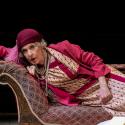
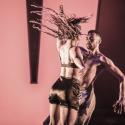


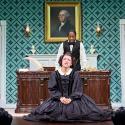






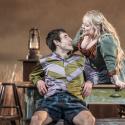
Add comment